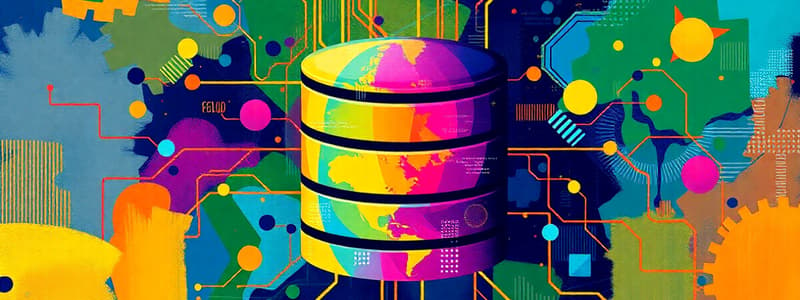Podcast
Questions and Answers
What is the primary distinction between data and information?
What is the primary distinction between data and information?
- Data is always meaningful, but information is sometimes not.
- Data is processed by people, whereas information is not.
- Data is raw facts, while information is organized and refined data. (correct)
- Data can exist without context, while information cannot.
Which of the following best describes the role of purposeful intelligence in the definition of information?
Which of the following best describes the role of purposeful intelligence in the definition of information?
- It regulates the flow of data in an organization.
- It enables data to be easily stored without processing.
- It is a technology that processes data automatically.
- It provides the context that transforms data into meaningful information. (correct)
What assessment method carries the highest weight in the overall grading scheme?
What assessment method carries the highest weight in the overall grading scheme?
- Proctored exams Final exam (correct)
- Quizzes
- Class participation
- Midterm Exam
How are relationships among data defined in order to create information?
How are relationships among data defined in order to create information?
Which assessment method is scheduled to occur during weeks 14 and 15?
Which assessment method is scheduled to occur during weeks 14 and 15?
What type of data representation involves a sequence of images?
What type of data representation involves a sequence of images?
Which characteristic is essential for ensuring quality information regarding its relevance?
Which characteristic is essential for ensuring quality information regarding its relevance?
Which statement best describes knowledge in the context of data and information?
Which statement best describes knowledge in the context of data and information?
In the context of information value, which of the following is classified as intangible?
In the context of information value, which of the following is classified as intangible?
Which type of information is considered tangible?
Which type of information is considered tangible?
What is a key factor that can significantly affect decision-making in an organization?
What is a key factor that can significantly affect decision-making in an organization?
Which aspect is NOT considered a characteristic of valuable information?
Which aspect is NOT considered a characteristic of valuable information?
What does a knowledge base consist of?
What does a knowledge base consist of?
Flashcards
Data
Data
Raw facts about an organization and its transactions, lacking meaning on their own.
Information
Information
Processed and organized data, imbued with meaning and purpose by analysis and interpretation.
Data vs. Information
Data vs. Information
Information is created by connecting data in meaningful ways; different relationships create different information.
CIS 1000
CIS 1000
Signup and view all the flashcards
Assessment Method
Assessment Method
Signup and view all the flashcards
Data Representation
Data Representation
Signup and view all the flashcards
Information
Information
Signup and view all the flashcards
Knowledge
Knowledge
Signup and view all the flashcards
Knowledge Base
Knowledge Base
Signup and view all the flashcards
Valuable Information
Valuable Information
Signup and view all the flashcards
Quality of Information
Quality of Information
Signup and view all the flashcards
Tangible Value
Tangible Value
Signup and view all the flashcards
Intangible Value
Intangible Value
Signup and view all the flashcards
Study Notes
Introduction to Information Systems
- Course title: CIS 1000
- Instructor: Assoc. Prof. Dalia Magdi
- Course aims:
- Overview five basic areas of information systems knowledge for business professionals, including conceptual system components and major types of information systems.
- Introduce fundamental concepts of competitive advantage through information technology.
- Review history, trends, and developments in microcomputer, midrange, and mainframe computer systems, basic computer system concepts, and major types of peripheral technologies (input, output, and storage).
- Review basic application and system software for enterprise and end-user computing.
- Introduce key database management concepts and applications in business information systems.
- Overview the Internet, telecommunication networks, business applications, and trends in technical telecommunications alternatives.
- Understand the role of e-business, e-commerce, and decision support systems.
Course Contents
- Course description and introduction
- Foundations of information systems in business
- Organizational strategy, competitive advantage, and information systems
- Ethics and privacy
- Information security
- Multimedia information systems (part 1 & 2)
- Data and knowledge management
- E-business and e-commerce
- Systems analysis and design
- Social computing (part 1 & 2)
- Information systems within the organization
- Business analytics (part 1 & 2)
Assessment Schedule
- Assessment methods:
- Weekly class participation
- Weekly quizzes
- Weekly assignments
- Projects (due dates: weeks 14 and 15)
- Midterm exam (date: week 8)
- Final exam (date: weeks 16 and 17)
Assessment Weights
- Class participation: 10%
- Quizzes: 10%
- Assignments: 10%
- Projects/Oral presentations: 10%
- Midterm exam: 20%
- Final exam: 40%
- Total: 100%
Data and Information
- Data: Raw facts about an organization and its transactions. Often has little meaning on its own.
- Information: Refined and organized data with purposeful intelligence. People provide the purpose and intelligence to create true information.
Data vs. Information
- Information is created by defining and organizing relationships among data.
- Defining different relationships leads to different forms of information.
Data Representation
- Alphanumeric
- Image
- Audio
- Video
Data, Information, and Knowledge (Continued)
- Defining and organizing relationships among data creates information.
- The process of applying knowledge to data (selecting, organizing, and manipulating data) transforms data into information.
Terminology
- Knowledge: Awareness and understanding of information. How to use information to support a task.
- Knowledge base: Data, rules, procedures, and relationships needed for a specific task.
Exercise (Data vs. Information)
- Examples: Date, Bank statement, Number 1355.76, Balance sheet, Bus timetable, Car registration plate.
- Data examples include: date, or numbers like 1355.76. The rest are Information.
The Characteristics of Valuable Information
- Inaccurate or incomplete information can lead to poor decisions, costing thousands or millions of dollars.
- The importance of different characteristics of data (like accuracy, timeliness, etc.) depends on the specific application or purpose.
Quality of Information
- Time: Timely, frequent, current
- Content: Accurate, concrete, relevant, reliable
- Form: Presentation, detail, clarity
Value of Information
- Tangible: Can be measured in terms of financial value (e.g., improved inventory control, reduced administration costs).
- Intangible: Cannot be easily calculated (e.g., greater customer loyalty, enhanced public image).
Exercise (Tangible vs. Intangible)
- Improved inventory control: Tangible
- Enhanced customer service: Intangible
- Increased production: Tangible
- Reduced administration costs: Tangible
- Greater customer loyalty: Intangible
- Enhanced public image: Intangible
Is your Data Hard or Soft?
- Hard data (quantitative): Uses figures like statistics to measure or quantify an object or situation.
- Soft data (qualitative): Focuses on describing qualities or characteristics of an object or situation, often collected through interviews, etc., to understand opinions and beliefs.
Sources of Information
- Formal communication: Structured and consistent presentation of information.
- Informal communication: Less structured information transmitted through casual conversations.
Studying That Suits You
Use AI to generate personalized quizzes and flashcards to suit your learning preferences.
Related Documents
Description
Test your knowledge on the fundamental concepts and components of information systems as covered in CIS 1000. This quiz explores key areas such as competitive advantage through technology, database management, and the role of telecommunications in business. Prepare to assess your understanding of the historical and current trends in information systems.




